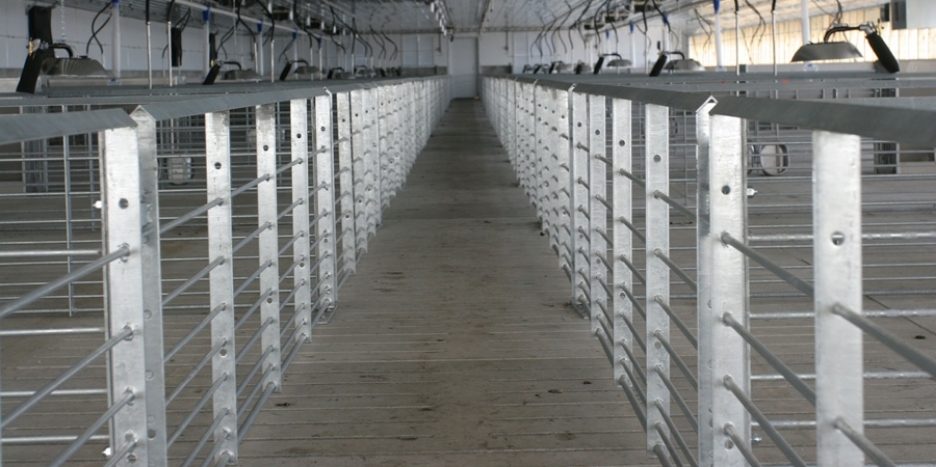2020 Iowa Pork Congress seminar puts focus on increasing equipment life.
Blog posts tagged with 'swine housing'
The size of individual sow farms continues to increase; just a few years ago 2,400 head units were considered large, but new sow farms under construction this year range between 5,000 to 14,000 head in size.
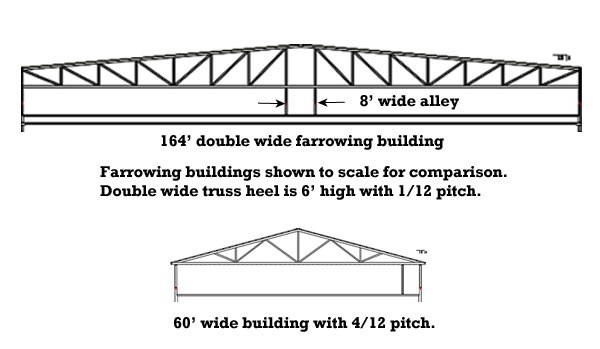
Building cross-section comparison
Designing the central production facility into two or three larger buildings has many advantages including smaller land requirements, less underground utilities to bring to the site, shorter roadways to build and maintain, fewer walkways between buildings and less linear footage of exterior building walls.
Because of increased pig capacities and the desire to minimize the number of buildings, it was necessary to increase the buildings widths up to 190 feet. Instead of the 4/12-pitch roof used on standard farm buildings, these jumbo-wide facilities utilize a two-piece rafter with a 1/12-pitch roof line resting on a center support wall in the middle. Almost 6 feet high at the heel with a center height of 13 feet, the rafters are designed more like a large floor joist. The outside appearance resembles a steel frame building more than conventional wood framed structures.
Breeding/ Gestation

Galvanized gestation stalls
Totally slatted flooring is a common feature of newly constructed B&G buildings. While past layouts consisted of a solid laying area with slat sections in the rear of the pen or stall only, new construction plans incorporate slats over the entire floor with stainless feeding troughs fastened in place. This arrangement allows long-term flexibility to reconfigure the pen layout in the future if needed.
Group housing with stanchions is the predominant type of housing under construction this year. Largely through trial and error, the industry seems to have settled into pen configurations containing eight to twelve sows. This pen size permits closer grouping by size and condition and promotes easier visual inspection.
Whether the production system chooses gestation stalls, stanchions, or ESF, most equipment is specified with hot-dipped galvanized equipment instead of painted finish. The extended equipment life provided by the galvanized finish makes this an economical business decision.
One advantage reported with stanchion systems is longer equipment life resulting from moving the water away from the front of the stanchions. Locating a cup or swinging water pipe with nipples in the center of the pen reduces the deterioration of feed pipes and stall fronts by minimizing water contact with these areas.
Farrowing

Large pen farrowing crates with SowMAX feeders
Jumbo style layouts permit designing a double farrowing building with an extra wide 8-foot center alleyway to aid in animal and people movement between rooms.
Almost every new construction project increases the length and width of the farrowing crates and creep area from the standard 5′ x 7′ footprint up to 6’ wide by 8′ long, with some systems choosing 8’6″ long crates. Longer framed sows and reduced piglet crushing rates from using wider pens have driven this trend. Again, the equipment will have a galvanized finish with a combination of cast iron, TriDek, or plastic slats for flooring choices.
Most production systems will incorporate some provision for ad-lib sow feeding. Besides reducing farm labor, ad-lib sow feeding is the most efficient method for feeding individual sows to reach full milk production potential. The type of systems can range from electronic transponder metering devices to sow activated hopper type feed dispensers.
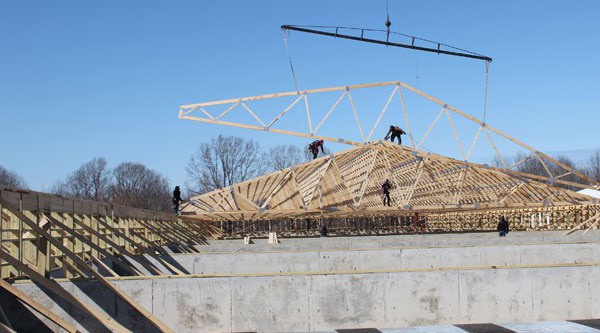
Swinging rafters on new farrowing house
Projects of this size require builders with an expanded skill set. A builder must be able to provide professional project management, understanding of regulatory issues, and increased insurance coverage. It is also critical for any construction firm undertaking projects of this size to have sufficient financial backing and the ability to manage large cash flows.
For more information about Hog Slat’s construction projects and swine production equipment offerings, contact your nearest sales representative by clicking here.
Not every labor saving idea for swine confinement lasted much past the initial development phase. From the 1960 Yearbook of Agriculture, we present the HOG-O-MATIC!
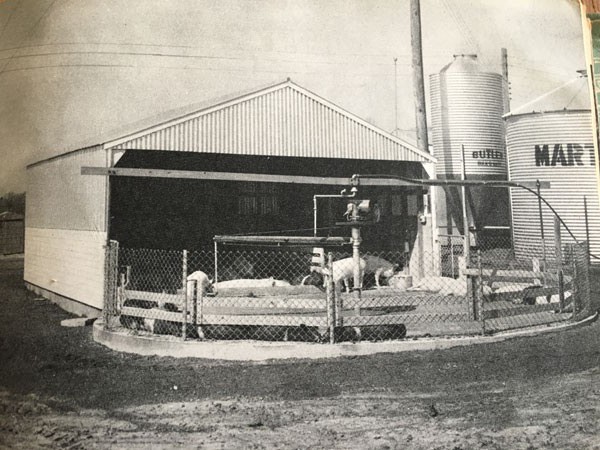
Hog-O-Matic
This automatic hog finishing facility – dubbed “Hog-O-Matic” – is equipped to feed the pigs and clean the floor under fully automatic control. Cleaning is done (below) with two jets of water under 70 pounds of pressure. The revolving boom circles the 21.5- foot exercise area every 2.5 minutes. A 4-inch center drain carries the wastes away.
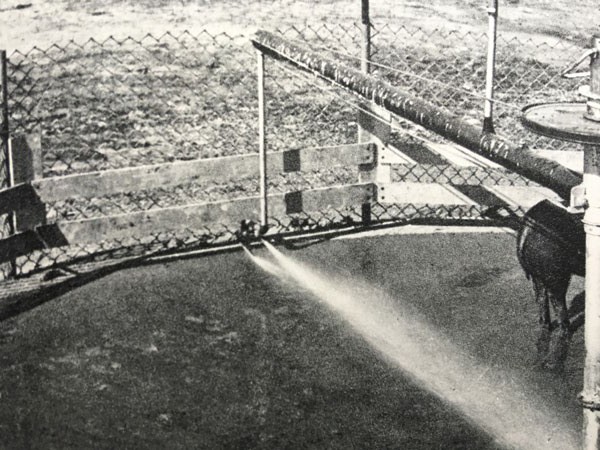
High-Pressure Water Jets clean pen floor
A good idea in theory for the time, but it is likely this system would not work well with sub-zero temperatures during a typical Midwestern winter. Here’s a more typical finishing floor from the early confinement years.
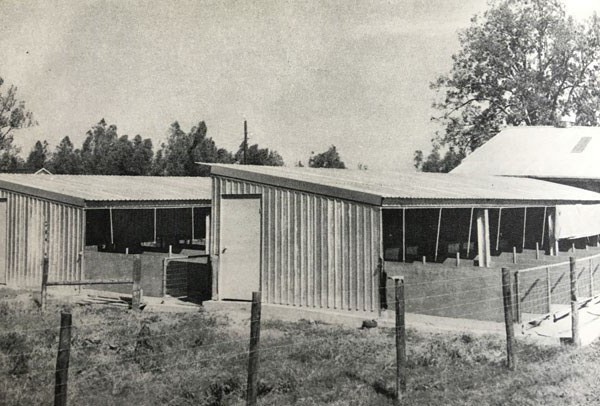
Reverse mono-slope finishing floors with rear access alley.
Hogs are housed in clean, airy, efficient buildings. The picture above shows one of the many new types of confinement housing during this time period. Raising hogs in confined quarters is a growing practice. The farmer designed this pen arrangement (below) with the plan of finishing two-thousand hogs per year.
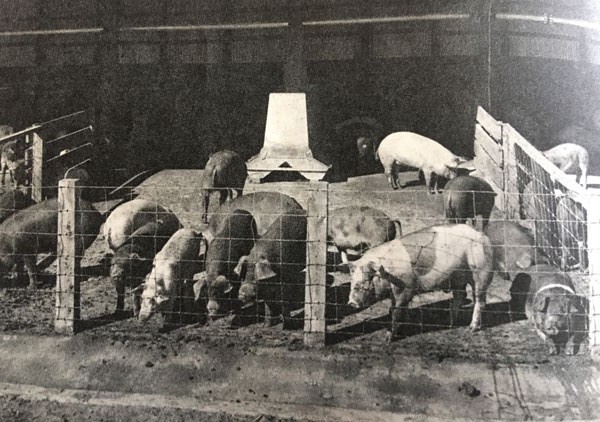
Labor-saving equipment included automatic watering and feeders filled with an overhead auger.
From these early designs, the industry continued to develop into the improved feeding and ventilation systems we have today. GrowerSELECT feed systems and AirStorm ventilation fans offer today’s producers great equipment backed by the best warranty in the business. To learn more call us at 800-949-4674 or go online at www.hogslat.com.
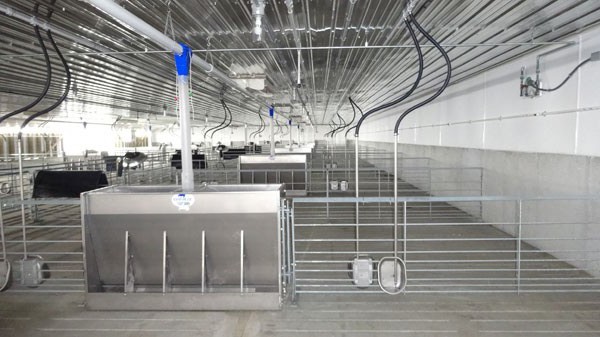
Interior view of a modern swine finisher constructed by Hog Slat.
Here’s another selection from the 1960 edition of The Yearbook of Agriculture on the latest trends in farrowing.
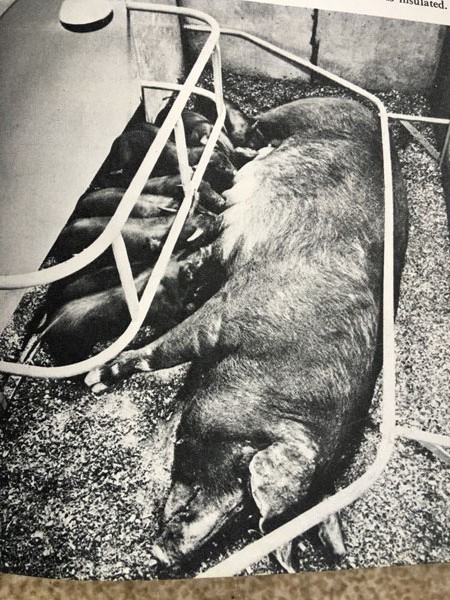
Welfare-friendly farrowing pens
Caption in yearbook:
In this minimum-stress pen, the shape of the guardrail encourages the sow to lie with the teats toward the pigs. The pigs stay where it’s warm – under the heat lamp and behind the guard.
How about this for Ad Lib feeding? An overhead auger delivers feed to the farrowing pens. No carts or scoops are needed.

Labor saving feeding from the past.
And finally, double-decker farrowing crates! I saw one of these set up in Red Oak, Iowa years ago.
From the yearbook:
Hogs in double-deck, all steel, cage-type farrowing stalls. The pigs are transferred after weaning. Manure is removed by mechanical drags.
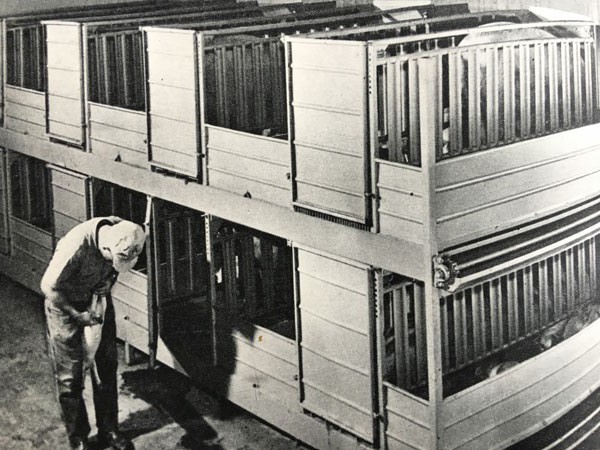
Double-decker farrowing crates.
Hog Slat manufactures a complete line of farrowing equipment for new construction or remodeling an existing facility. Our SowMAX ad lib dispenser feeds lactating sows 24/7 while reducing farm labor. See more at www.hogslat.com or call 800-949-4647.
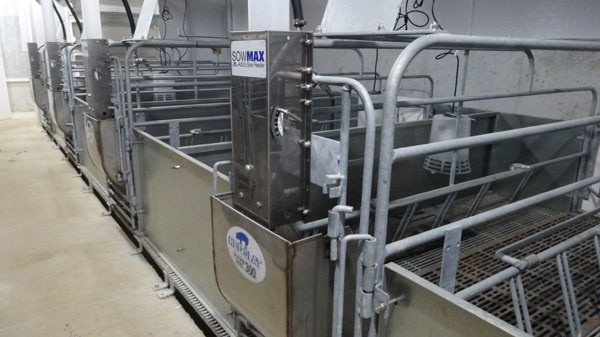
Galvanized Hog Slat farrowing crates with SowMAX Ad Lib dispensers, Cast/ TriDEK floors, and Poly Lamps
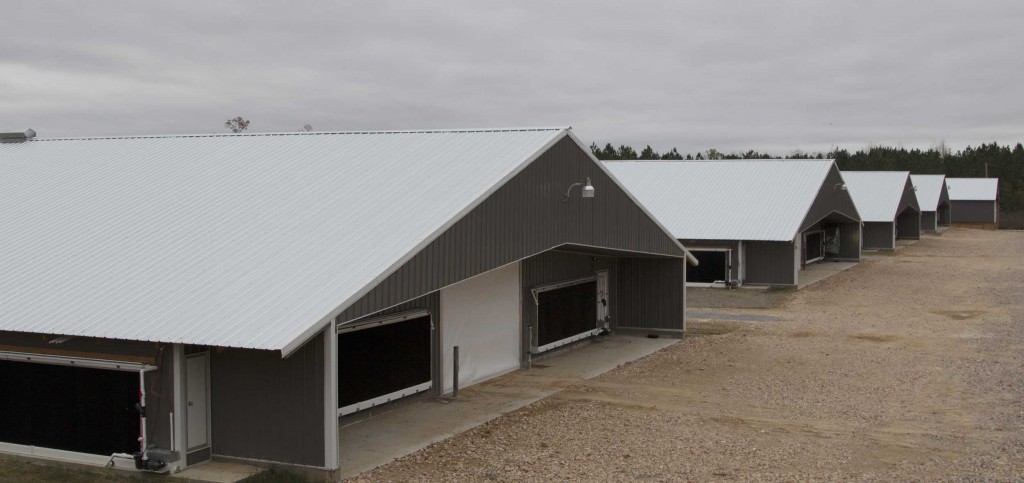
Broiler houses at a Georgia farm.
When it comes down to it, the cost of manufacturing a high-quality product is the same for most companies producing equipment for the livestock and poultry markets. Most companies have identified the most efficient methods to build an anchor bearing, motor, feeder, nipple waterers, etc.
The real cost difference comes from the delivery of those products to the end user. The standard model of distribution, in our industry, involves a manufacturer producing a product line, warehousing it, and employing a sales force to establish a dealer network.
The dealer network stocks the equipment, maintains a storefront, hires salespeople, installs, and services the production systems in a local area for the brand of equipment they represent.
This particular type of distribution model has changed very little over the history of the livestock and poultry production industries. Each member of this distribution model is an independent business entity and is free to add whatever margins they deem necessary (or possible) to the final cost a producer pays.
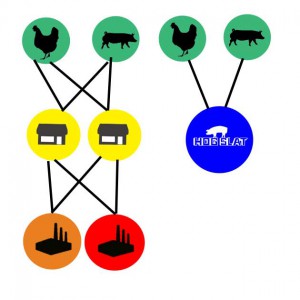
GrowerSELECT supply chain removes extra margins to reduce the final cost to end users.
Sold through a different type of distribution model, GrowerSELECT goes directly to livestock and poultry growers through our network of regional local stores. Because we own the distribution chain from top to bottom, we add only ONE MARKUP over our cost.
Our cost is based on finished goods plus ONE MARKUP vs. MULTIPLE MARKUPS from the typical distribution model.
Also, we would suggest that we are the low-cost producer for most products. Wait a minute; the first paragraph said the cost of manufacturing was the same for everyone.
True. But if a brand has a loyal dealer network, the pricing to the dealer network will not be challenged. A loyal dealer will continue to buy brand name products even if the cost is excessive.
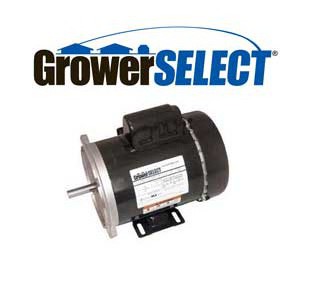
GrowerSELECT auger motor with 2-year warranty.
Name brand motors are a perfect example of this. An auger or fan company buys a motor from a motor manufacturer, puts their logo on it and sells it to a local supplier. The local supplier sells the motor to the end user adding little value to the final price. A local supplier has few other options. Their volume of a particular motor isn’t high enough to go directly to a motor manufacturer, and they have little negotiating power with their chosen brand vendor. The brand company has little incentive to lower the cost to a loyal dealer network. In fact, a brand company can charge different prices in different geographical locations depending on market pressure.
Compare this with GrowerSELECT motors. Our network of over 70 store locations and turnkey construction business allows for large purchases of motors direct from a manufacturer. We forecast purchase amounts for each store location and ship directly with minimal warehousing cost. Local retail pricing continually drives us to buy at a more competitive price.
The conventional distribution chain is directed from the TOP DOWN versus the GrowerSELECT model which is driven from the BOTTOM UP. Lower pricing for comparable products is the result.
The GrowerSELECT distribution model also affects product responsibility. Because we interact directly with the end users, we deal directly with any problems arising with the installed products. We sell it; we service it, and the end user works with one company.
The traditional marketing chain allows room for some question regarding who is responsible for dealing with equipment failures when those problems arise. The manufacturer can blame poor installation, dealer system design, or a number of other reasons (excuses) for a product’s failure. A local supplier can blame the brand company for poor design or manufacturing flaws. The GrowerSELECT distribution system eliminates “finger pointing” and focuses on providing accountability to each and every customer.
 Our customers produce commodities. The lowest cost commodity producer is always the most successful. Our mission is to provide our customers long term value at the lowest possible cost.
Our customers produce commodities. The lowest cost commodity producer is always the most successful. Our mission is to provide our customers long term value at the lowest possible cost.
Ask yourself this question; “Are all the manufacturers, distributors, dealers, installers, and service personnel creating ADDED VALUE in the distribution chain I buy from?” If you hesitated while answering that question, take the next step by changing the way you buy and implementing GrowerSELECT equipment into your operation.
To contact a sales representative in your area or find our nearest locations to you, click here.

Most commercial broiler farms utilize an evaporative system to provide cooling during hot weather. Although there is no substitute for regular maintenance and cleaning, choosing the right system can reduce repairs. In part one, we compare Hog Slat’s trough design and features against competitive brands.
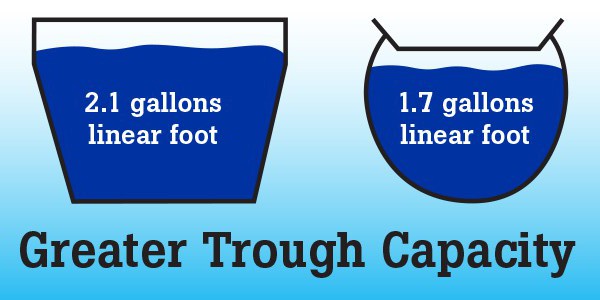
Hog Slat’s Evap System features a square trough to increase the water reservoir by over 24% when compared to 8″ PVC pipe. This extra capacity allows water draining from the pads to be collected for re-circulation without overflowing. In a typical 80′ system this adds up to 168 gallons compared to only 128 gallons for an 8″ diameter PVC trough.
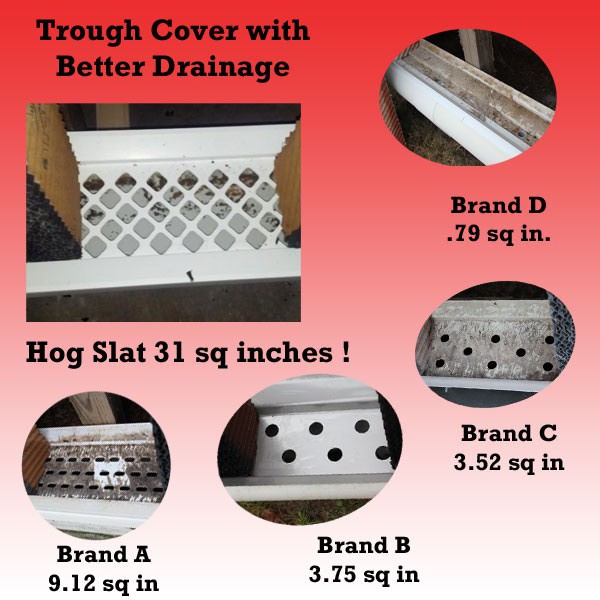
The Hog Slat trough cover is designed with more inches of open area to permit faster drainage away from the bottom of the pads. If the pad bottoms remain saturated, they can get soft and in extreme cases sag and fall out of the system. We show a comparison of the amount of open area per linear foot of trough.
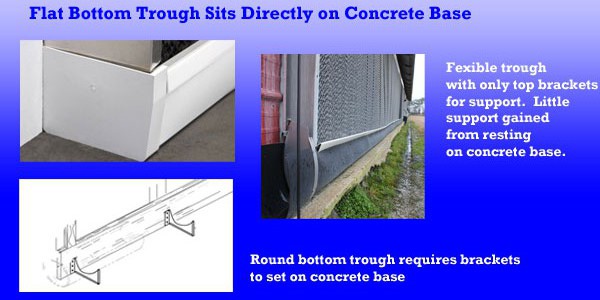
The most secure method for supporting the trough is to place the bottom directly on a concrete base. This type of installation eliminates the need for support brackets. The flat bottom of the Evap System sits directly on a concrete pad without additional supports.
Troughs with round bottoms such as a pipe or U-shaped troughs require the use brackets to hold them on the concrete. The bottom doesn’t sit directly on the concrete, with damage to the trough resulting from the brackets cutting into the plastic.
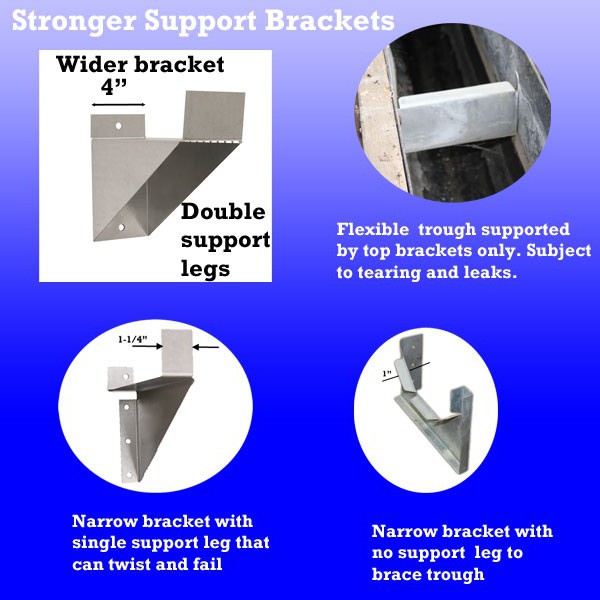
For installation requiring brackets, the Hog Slat design provides better support. The heavy Bi-Fold bracket is a full four inches wide and spreads the bearing load over a greater area compared to narrow brackets. The bracket also features two support legs instead of one to prevent twisting.
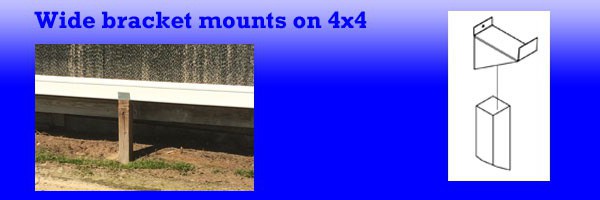
Hog Slat’s wide 4″ bracket allows mounting on a 4×4 post when building framing lumber is not available or system is installed away from the building.
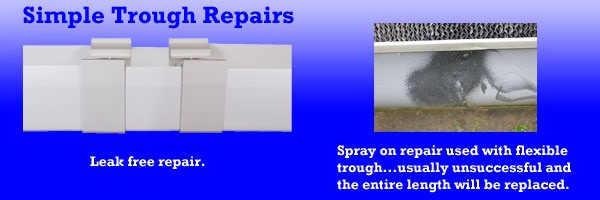
Trough repairs are simple and leak free by using two couplers. Repairs to round bottom trough are time-consuming and often results in leaks.
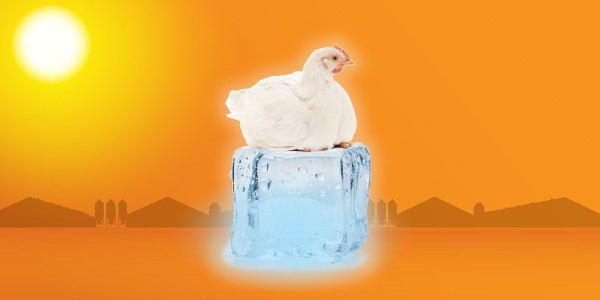
Most commercial broiler farms utilize an evaporative system to provide cooling during hot weather. Although there is no substitute for regular maintenance and cleaning, choosing the right system can reduce repairs. In part 2, we compare pad, distribution and fasteners of Hog Slat’s Evap System against competitive brands.

The Evap System features a large capacity spray bar with more holes per running foot to reduce pad streaking. Attaching the sections with bell connectors eliminates the dry areas in the pad common with coupled spray bars.

Pad saturation is enhanced because the top deflector angles the water flow to the outside of the pad. By directing the water to the outside surface, the water is pulled through the pad wetting the full 6″ width. Designs with the water deposited in the middle of the pad may not utilize the entire pad.
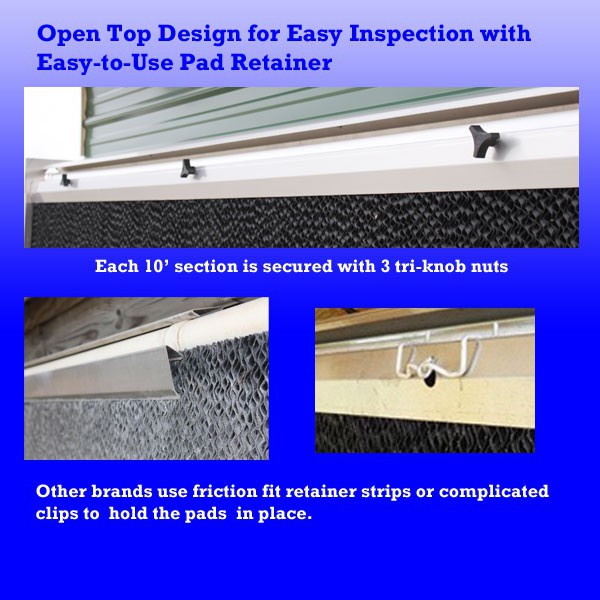
The Hog Slat system features three robust, easy-to-remove, Tri-Knob nuts with brass inserts to hold each aluminum pad retainer in place. Each section of the deflector and pad retainer is joined with connector clips to prevent dips or bows in the installation.
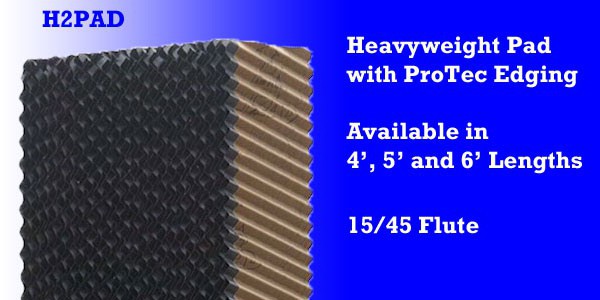
Manufactured from heavyweight Saturation Grade Kraft paper for high absorption rate and glued with proprietary resins mixed with additives for fire resistance and fungus protection. H2PAD pad is then triple cured in precisely controlled ovens and cut to exact lengths. 3/4″ ProTec edging extends pad life by protecting against UV and mechanical damage. Additional ProTec coating is available on the pad bottoms to guard against premature damage.
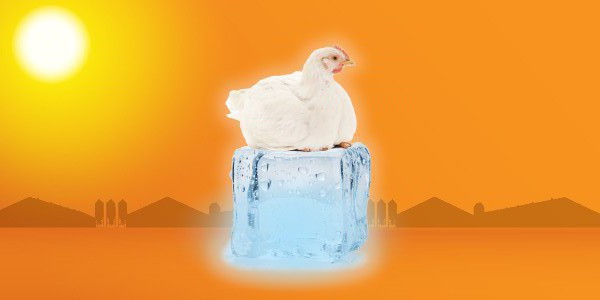
Most commercial broiler farms utilize an evaporative system to provide cooling during hot weather. Although there is no substitute for regular maintenance and cleaning, choosing the right system can reduce repairs. In part 3, we compare pump and sump tanks options for Hog Slat’s Evaporative System.
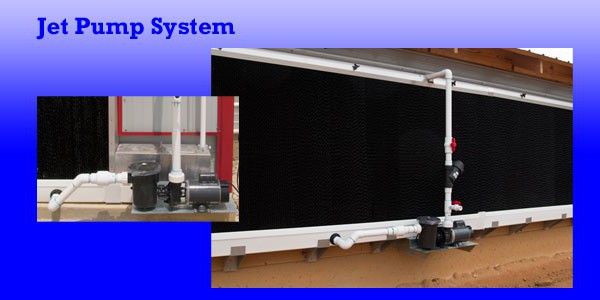
The jet pump system has several advantages starting with an open, drip proof, air cooled motor that does not have to operate in water. Repairs are less expensive because a jet pump has two components; the motor can be replaced separately from the impeller assembly. Repairs are easier with a jet pump because the assembly is above ground, and you don’t have to pull the pump out of a sump tank like a submersible pump to perform repairs. The strainer basket protects the impeller assembly from debris.
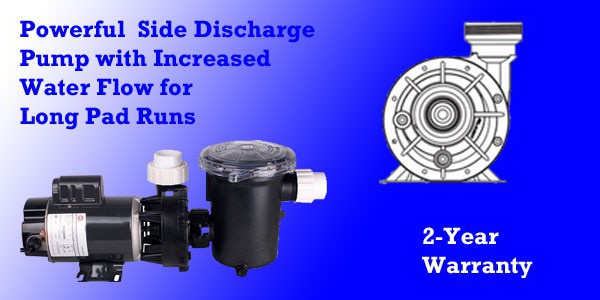
Side discharge design delivers higher volumes than competitors center discharge pumps so water reaches the ends of long pad runs. 3/4 hp pump is available in 115V or 230V models.
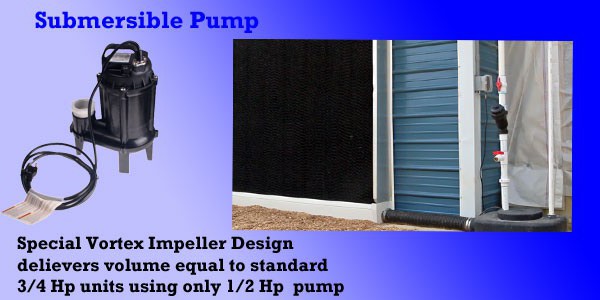
The Hog Slat submersible pump is specially designed for cool cell system applications and not just adapted from other industries. Re-designed vortex impeller produces lower head pressure and higher water volume, resulting in an efficient 1/2 hp pump with the same output as normal 3/4 hp submersible pumps.
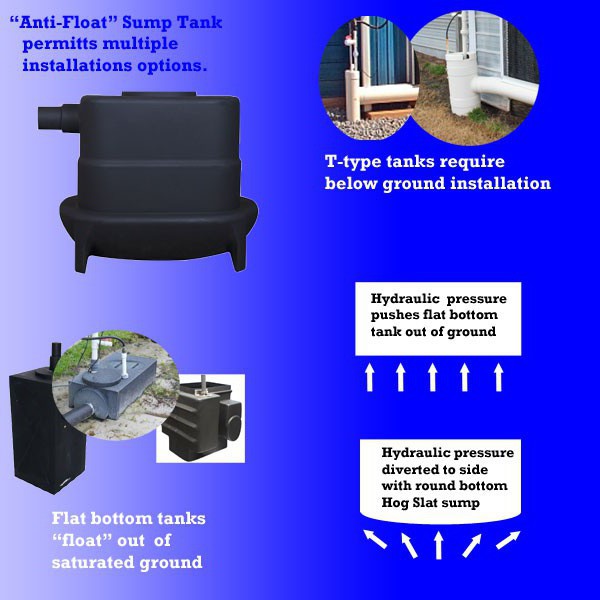
The Hog Slat sump tank design does not require it to buried in the ground like conventional T-Tank sumps. On systems where trough height permits an above ground installation, the tank will set directly on a concrete pad. For below ground installations, the Evap System sump tank features a molded lower lip with a rounded bottom profile to help prevent it from “floating” out of saturated ground when the tank is empty.
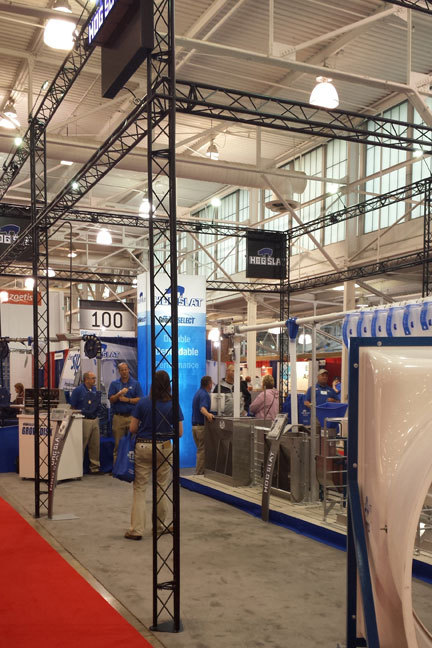
Another successful show is in the books for Hog Slat at the 2015 World Pork Expo in Des Moines, Iowa. This year, Hog Slat displayed several new items, including our AirStorm fiberglass ventilation fans, Grow-Disk™ chain disk feed system and the GrowerSELECT® curtain machine. In addition to these new products, we also featured our concrete slats, TriDek flooring, group pen feed stanchions, GrowerSELECT sow drops and more.
Hog Slat hosted a group of Chinese pig farmers that were visiting the United States and attended the World Pork Expo. On Tuesday, as part of their trip, we visited a brand new 2 barn finishing site Hog Slat just completed, located in Lohrville, IA. The group was able to see a new group of pigs that had just been loaded into one of the barns earlier that afternoon, and also examine the inside of the other barn that had not been loaded with pigs yet.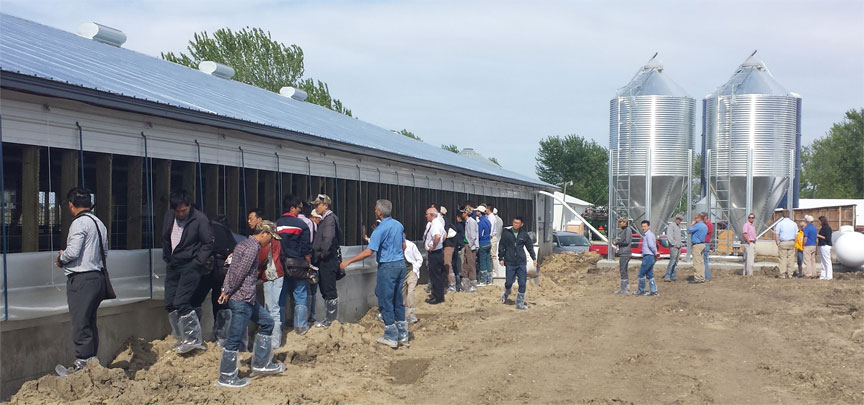
Both of these deep pit barns were equipped with GrowerSELECT Grow-Flex™ feed systems, Hog Slat wet/dry hog feeders and AquaChief cup waterers as part of their equipment package. The group was very impressed with the fit and finish of Hog Slat’s feed system equipment and building construction. To learn more about new construction or remodeling hog barns in the Midwest or other areas of the United States, please visit the Hog Slat sales representative locator, found here.
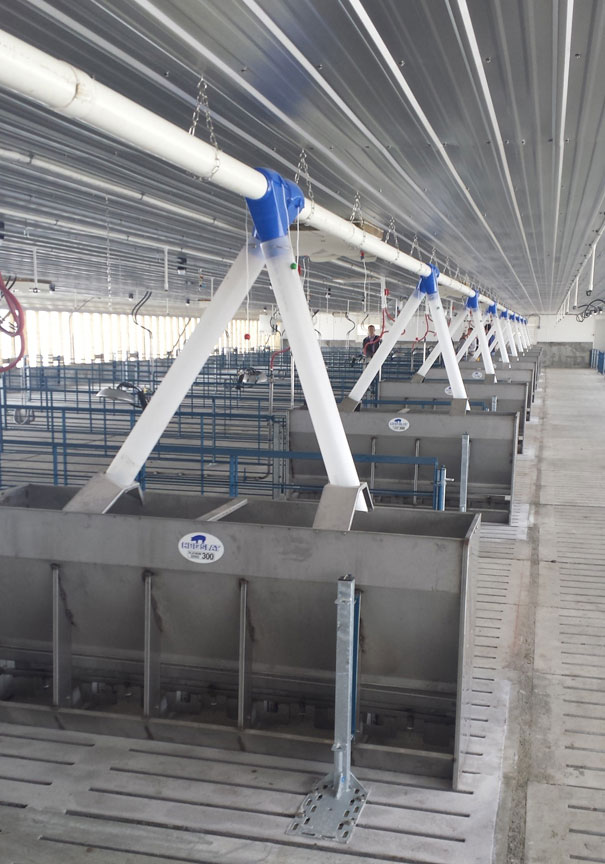
Hog Slat will be exhibiting at this year’s World Pork Expo with many new and further developed swine equipment products, highlighting Hog Slat’s GrowerSELECT product line.
At the show, Hog Slat will have a large variety of equipment on display in both the exhibition hall (Booth V165 VIB) and at the Hog Slat hospitality tent (Tent G234). Equipment that will be on display includes Hog Slat’s Grow-Flex Feed System, Grow-Disk Feed System, Slats, and an introduction to Hog Slat’s AirStorm fans. We invite you to stop by the Hog Slat booth to see what’s new at the show.
Enjoy FREE ADMISSION to the 2015 World Pork Expo, courtesy of Hog Slat. You may redeem your admission voucher by registering online at www.worldpork.org by May 28th and use voucher code HogSlat2015. Or, present a hard copy of our voucher (available through the Hog Biz, local Hog Slat retail stores, or your local sales contact) during on-site registration the day of the expo. Expo registration is located in the Animal Learning Center inside Gate 15.
Craving some good BBQ? Stop by the Hog Slat hospitality tent anytime during expo to enjoy Vinny’s BBQ, located in Dakota City, IA. Vinny’s will be serving lunch and dinner both Wednesday and Thursday of the expo.
The World Pork Expo is held June 3rd-5th in Des Moines, IA at the Iowa State Fairgrounds. Visit us at the show in booth V165 in the Varied Industries Building and Hospitality Tent G234. We hope to see you at the show!
- 1
- 2
- 2026
- 2025
- 2024
- 2023
- 2022
- 2021
- 2020
- 2019
- 2018
- 2017
- 2016
- 2015
- 2013












 Україна
Україна Méjico
Méjico